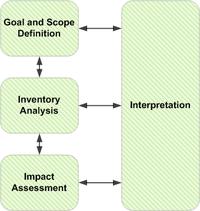
Photo from wikipedia
Abstract Purpose This study uses the life cycle assessment (LCA) method to calculate and compare the life cycle greenhouse gas (GHG) emissions from battery electric vehicles (BEVs) and conventional gasoline… Click to show full abstract
Abstract Purpose This study uses the life cycle assessment (LCA) method to calculate and compare the life cycle greenhouse gas (GHG) emissions from battery electric vehicles (BEVs) and conventional gasoline internal combustion engine vehicles (ICEVs) in 2010, 2014 and 2020 under different scenarios, including different electricity mixes, electricity generation technologies and combined heat and power (CHP) scales, as well as discusses the GHG emission reduction potential of BEVs throughout their life cycle. Methods The LCA system boundaries, including the vehicle cycle and the fuel cycle, are examined in accordance with the ISO 14040/14044 standards. The China Automotive Life Cycle Database (CALCD), which is the first and primary life cycle database of the China automotive industry, was used. The compositional data for the vehicle components and the battery material were obtained from the GREET2 2017 model. Results and discussion As the electricity mix is optimized, the electricity generation technology is advanced, and the CHP scale is increased from 2010 to 2020, the total life cycle GHG reduction potential of BEVs will gradually improve, reaching 13.4% in 2020, relative to ICEVs. Conclusions The sensitivity analysis shows that the GHG emissions from electricity, the percentage of fossil fuel in the electricity mix and the electricity consumption of the BEV during use are important parameters influencing the GHG emission reduction potential of BEVs. By adjusting the electricity mix, advancing electricity generation technologies and increasing the CHP scale, the GHG emission reduction potential of BEVs can be improved.
Journal Title: Journal of Cleaner Production
Year Published: 2018
Link to full text (if available)
Share on Social Media: Sign Up to like & get
recommendations!